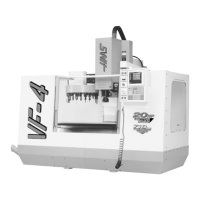50
INSTALLATION
June 1999
96-8000
9. As the process continues, the leveling screws are turned in smaller increments 1/4 turn, 1/8
turn, and smaller. Also, as the machine is leveled, make sure that the tension continues to be
equal on the screws at all four corners.
NOTE: The following procedure for fine leveling the machine must be performed
exactly as noted to ensure machine will meet all quality standards for machin-
ing operations. Failure to follow these guidelines will prevent the machine
from being truly leveled and result in poor machining finishes.
FINE L EVELING
10. With the table centered, place the bubble level in the center of the table parallel to the X-axis.
Using the jog handle, move the Y-axis, stopping at the front, middle, and back of the travels. The
objective is to adjust the level to make the Y-axis guides parallel. The bubble level must indicate
the same reading at each position (front, middle, back). Note the movement of the bubble and if
the table is at front or back of travel. If the bubble moves, for example, to the right and the table is
at the front of the travel, lower the right front corner adjustment screw slightly. Repeat the proce-
dure until you get the bubble steady from front to back. This is the only leveling adjustment that
can be done.
The following procedure is simply a check of machine level. If it does not meet specifications, then you must
repeat this operation. Do not adjust the middle screws at this point.
Refer to the Machine Inspection Report that accompanies your machine. Check your results with those of the
report under the Table Travel Flatness verification. By duplicating these results exactly, you will obtain the
same alignment specifications that were achieved at the factory.
11. Place a 0.0005 test indicator in the spindle and sweep a 10" diameter circle on the table (See the
Machine Inspection Report in the manual for the results of this test at the factory). Grease the
dimple in each of the two remaining pads, locate them under the middle leveling screws, and use
these screws to compensate for any error. If there is no error, tighten the screws evenly until they
contact the pads.

